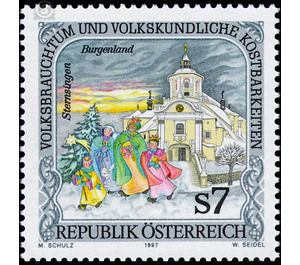folklore - Austria / II. Republic of Austria 1997 - 7 Shilling
Theme: Architecture
| Country | Austria / II. Republic of Austria |
| Issue Date | 1997 |
| Face Value | 7.00 |
| Color | multi-colored grey |
| Printing Type | combination printing |
| Stamp Type | Commemorative |
| Item Type | Stamp |
| Chronological Issue Number | 1551 |
| Chronological Chapter | OOS-OE2 |
| SID | 27834 |
| In 63 Wishlists | |
Epiphany parades, Epiphany games and also the Epiphany singing enriched the Christian tradition over the centuries. Of these various customs, only the Three Kings singing, better known as "star singing", has survived to the present day. The very important position that the "Three Holy Kings" took in the religious life of people is expressed in legends and also in the singing of the stars. Epiphany singing is, according to some theories, an independent custom from the 16th century. Probably the usual New Year singing was converted into a three king singing. Three students disguised as kings, mostly accompanied by a teacher, roamed the streets asking for a gift. The most important prop, the star, could never be missed. Not at all times did the Epiphany singing receive undivided applause. The custom was often discredited, prohibited or permitted only with special permits. All these difficulties and also the ideas of the Enlightenment, which cut off the thread of so many traditions, could not bring the Three Kings singing to a standstill. Even in our century, star singing survived the political and social upheavals. In Austria, more than 70,000 children go from house to house, announcing the message of the birth of Jesus with their songs and collecting donations for people in need in the "Third World". The brand image shows a star singers group from Burgenland.


